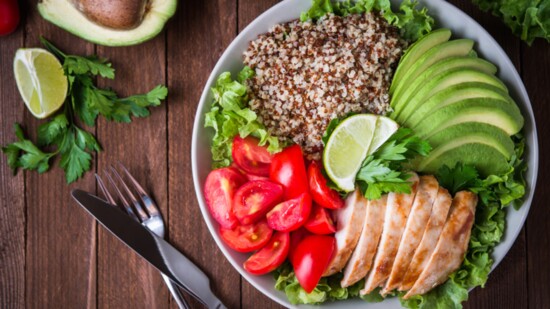Athletes, even "weekend warriors", always look for an edge. Training, recovery (including plenty of sleep), mental well-being, positive thoughts and healthy nutrition are all part of the plan. Peak performance starts with healthy eating, and that includes consuming whole foods instead of processed foods. If it comes in a box, bag or wrapped in plastic, eat sparingly.
The energy needs of athletes are greater than those of the average healthy person, say the experts at UW Health in Madison (WI). It’s not uncommon for athletes, especially when young and growing, to have daily caloric needs from 2,200 — 3,000 calories. The amount of energy found within a given food is dependent on its macronutrient (carbohydrate, protein and fat) content:
- Carbohydrates serve as the primary source of energy during activities of higher intensity. Healthy carbohydrate food sources include fruits, vegetables, whole-grain cereals, breads and pastas. Choose whole-grain carbohydrates (such as whole-grain bread or pasta) and fiber-rich cereals for power-packed energy. Limit refined grains and sugars (sugary cereals, white breads and bagels).
- Proteins play a key role in muscle repair and growth, with the best including lean meats, eggs, dairy (yogurt, milk, cottage cheese) and legumes. When picking protein stick to chicken, turkey, fish (the darker the flesh the better), peanut butter, eggs, nuts and legumes.
- Dietary fats also play an important role in helping individuals meet their energy needs, as well as supporting healthy hormone levels. Healthy fats come from nuts, nut butter, avocados, olive and coconut oils. Avoid common vegetable oils such as corn, cottonseed or soybean.
Fruits and vegetables are filled with the energy and nutrients necessary for training and recovery. Plan to eat a variety with the goal of at least five servings per day, while varying the types of fruit and the colors of vegetables. (Note: one serving is about the size of a baseball.) Plus, these antioxidant-rich foods will help fight off illnesses like a cold or the flu.
Staying hydrated is critical before, during and after exercise. As little as a 2% drop in hydration level can negatively impact your performance. Choose water first, then milk, 100% fruit juice and sport drinks. It's important to understand that fruit juice and sport drinks will be high in sugar. Also, don’t confuse sports drinks with "energy" drinks stuffed with sugar, caffeine and more than a few hard-to-pronounce chemicals.
When training or competing, please remember to consume a minimum of:
- Two cups of fluid prior to training.
- Four to six ounces of fluid every 15 minutes of exercise.
Post-event hydration needs vary by sport. To properly assess yours, weigh yourself immediately before and after a workout. For every pound of weight lost, replace with 16 ounces of fluid. The quickest recovery choices include water, low-fat milk or healthy juice. If you are into sports beverages check out some of the new options available online or at warehouse stores. The new class of powdered hydration aids are tasty, easy to mix with water and better balanced for electrolyte replacement.
Remember: proper nutrition does not happen on the day of the event alone; it happens in the days, weeks and months leading up to the competition.
- As the big game, race or competition approaches, make sure your meals are getting smaller. Also consider limiting dairy, fat and fibrous carbohydrates an hour or two beforehand. Nobody needs an upset tummy before the starting whistle.
- Avoid experimenting on yourself with a new supplement or protocol on game day; instead, test any changes earlier during training to learn whether you tolerate it well.
About the Author: Trevor Gere and his wife, Jennine, are owners of the Smart Fit Method in Kildeer (SmartFitMethod.com/location/Kildeer).
Each meal, fill your plate with one carbohydrate, protein and healthy fat each.
